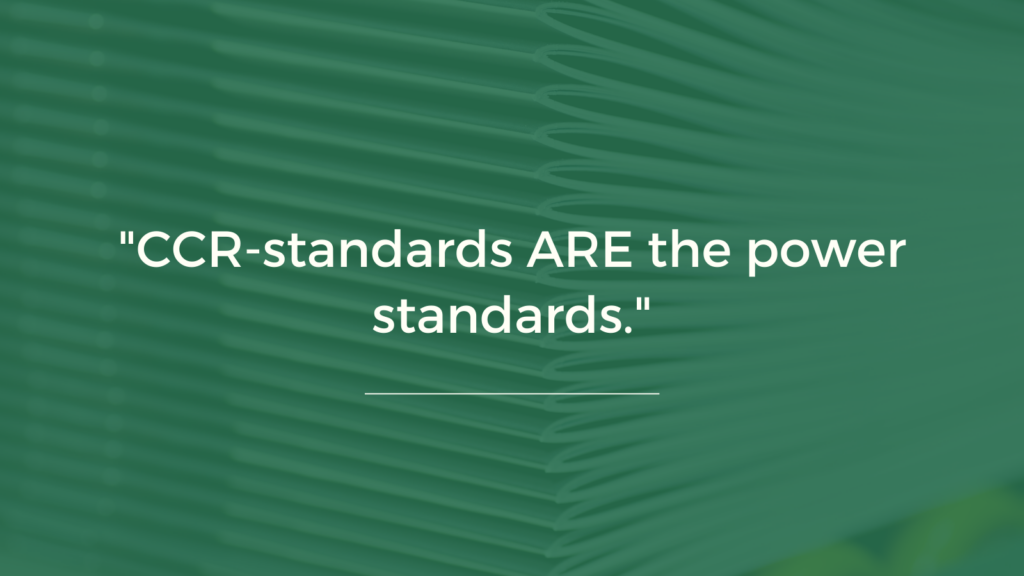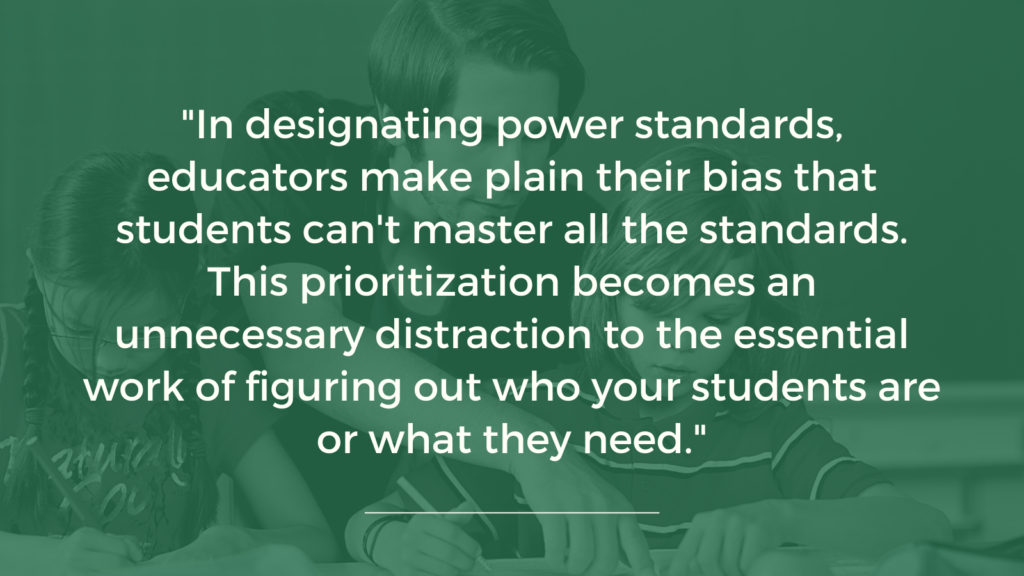Lately, we have gotten a few text messages from colleagues like the one on a recent Saturday night: “How do I respond to this?!“ with the screen capture of a message asking, “What 5-7 ELA/Literacy standards do you think are power standards for 5th graders to master?” As schools and districts turn toward planning for next school year, sometimes this work includes arbitrarily drafting “power ELA standards” (or “focus standards,” “essential standards,” etc.). We cannot say this loudly enough – please do not.
Why might we name power ELA/literacy standards?
Educators often name power standards for any number of reasons: they always have, it’s seen as a productive lever for struggling schools; leaders want a literacy pacing calendar for teachers to follow; or systems want standards-based reporting for students. These might be compelling reasons, but the solution of power standards is not the best pathway for ensuring the success of all students. Selecting power standards is a way of proceduralizing the standards that takes considerable time for educators to do but is not meaningful for student learning. This proceduralizing decenters what is most essential: the students and their relationship to and interpretations of the texts under consideration.
When faced with challenges in literacy instruction (be it a lack of opportunity for students to access grade-level work, a disrupted school year, or otherwise) schools and districts would do well to focus on supporting their students to engage in meaningful, affirming, grade-level work with texts. More on what that might look like in a moment. First, a word on why isolating power standards cannot lead to student success.
Why is naming power ELA/literacy standards a bad idea?
Naming power standards may have been a common strategy when there were many, many standards prior to the wide adoption of college- and career-readiness standards (CCR standards) in 2009. This is not the case anymore. CCR standards ARE the power standards. They are streamlined; they are connected within and across grade levels, and they create a staircase of complexity for students to climb from kindergarten through 12th grade. There are no power standards that should sit above this set of CCR standards.

If we focus our work with students on only a narrow selection of standards, we are not providing consistent opportunities for grade-level work for all students, and we fail in our task to prepare students for the demands of college, careers, and citizenship. Naming power standards is a policy move that increases inequalities by defining opportunity gaps. This kind of gap in opportunity to meet grade-level standards is already a pernicious problem in schools and districts. Far too often, Black students, students learning English, and students currently experiencing poverty are repeatedly denied access to grade-level learning (see TNTP’s Opportunity Myth). This opportunity gap is problematic for certain, but cannot be solved by creating a policy that names fewer skills for students to master.
Keep in mind that CCR-standards state a minimum of what students should be able to do by the end of each grade level. As such, they are best seen as necessary but not sufficient for ensuring equitable learning opportunities for all students. In designating power standards, educators make plain their bias that students can’t master all the standards. This prioritization becomes an unnecessary distraction to the essential work of figuring out who your students are or what they need. To support equitable instruction, educators should instead consider who their students and their communities are and spend time making decisions about the curriculum, instruction, and pedagogical approaches that best suit these needs.

Finally, naming power standards decenters the students as the primary actor in interpreting and learning from texts. The CCR-standards reflect the integrated and text-centered nature of literacy by naming the various ways students should be able to read, discuss, and write about the world from rich and rigorous texts. If you isolate some standards over others, you deny students the opportunity to fully learn from these compelling texts, and you lean in on skills-first (rather than text-first) instruction. Take, for example, the two different text excerpts below. As you read, consider what questions and tasks you might engage students in to unlock the richness of each text individually and then of both together.

What did you think are the most important things for students to dig into with these texts? If students examined the texts through “power standards” only, then the questions and tasks will be driven by the skills in those standards rather than students exploring, learning from, and reacting to the content and construct of the texts. In the case of these Gorman texts, if a district selected Reading 1 and 2, Writing 2, and Speaking and Listening 1 as part of their “power standards,” students could engage in a discussion about Gorman’s perspective of American democracy and write a paragraph explaining the purpose of poetry according to Gorman. But, if the district left out Reading 5, 6, 7, Writing 5, and Speaking and Listening 3, students would not get the opportunity to compare and contrast Gorman’s poem with her reasons for writing as she shares in “Using Your Voice is a Political Choice,” discuss in small groups the ways in which Gorman’s point of view shaped both texts, describe in writing how reading “The Hill We Climb” at a presidential inauguration impacts the poem’s meaning, or write their own occasional poem to read at an important community event. And what about the next texts students engage with? Will the power standards districts select best address the complexities of these texts and the myriad opportunities to analyze across the standards? It is unlikely. By arbitrarily naming specific standards disconnected from any experience with texts, we are narrowing students’ opportunities to fully analyze and deeply know the meaning of Gorman’s work. Keeping text at the center of literacy instruction means giving students the opportunity to read and grapple with grade-level texts, not artificially isolating certain standards away from others.
What should we focus on instead?
So what might schools and districts do if they don’t name essential standards? First and foremost, ensure you are providing students regular opportunities to engage with and learn from grade-level complex texts. Guidance for how to do this can be found in Placing Text at the Center of the Standards-Aligned ELA Classroom or A Short Guide to Placing Text at the Center of Learning, which includes stopping instructional approaches that stand in the way of access to grade level materials. With the text(s) at the center, use the range of standards to drive questioning and to bring focus and clarity to text-driven culminating tasks. In the table below, we have outlined additional approaches and resources to better meet the needs of your students.
| Actions That Prioritize Student Learning | Resources to Support Student Learning |
| Accelerate learning for students not yet at grade level. Be strategic about how to know what opportunities to learn students did not have and how to provide them just-in-time support into grade-level materials. |
A report on accelerating literacy and creating equity: Reading as Liberation – An Examination of the Research Base. Rethinking Intervention from Instruction Partners For young readers, focus on the Early Reading Accelerators For older readers, consider integrating literacy accelerators into content teaching with tools like Building Fluency: A Guide to 6-12 ELA/Literacy from UnboundEd. |
| Adopt a CCR standards-aligned curriculum as a start to engaging students in learning with grade-level texts and tasks. |
A list of freely available ELA instructional materials Curriculum Support Guide from Instruction Partners to support adoption and implementation of CCR-aligned materials Textbook Adaptations for better alignment of basal materials |
| Expand culturally relevant pedagogies in schools and districts. Because standards are necessary but not sufficient, we must attend to how we approach literacy instruction, what knowledge we privilege in the classroom, and who our students are as essential components of teaching and learning. |
Gloria Ladson Billings on Culturally Relevant Pedagogy
A Culturally Responsive Instruction: Resource List from Colorín Colorado Complicate the narrative and tasks for students with resources from #DisruptTexts, Learning for Justice’s model Reading Diversity, and Why You Need to Diversify Your Diverse Books from Zoretta Hammond |
| Ensure teachers have sufficient time to internalize texts and their complexities, and the support to plan appropriate scaffolds. |
Achievement First’s Intellectual Prep: What We’ve Learned UnboundEd’s Planning Process Principles for High-Quality, Standards-Aligned Professional Learning |
| Address interrupted schooling due to COVID-19 closures and disruptions |
Council of the Great City Schools: Addressing Unfinished Learning After COVID-19 School Closures TNTP’s Acceleration Guide The Priority Instructional Content to support a text-centered approach while also accounting for the last year of interrupted time at school. Note: The Priority Instructional Content is different from power standards in that it suggests a focus on standards that represent the major work of literacy instruction: learning to read, close reading of complex texts, and volume of reading to build knowledge. The remaining standards work in service of this instructional focus, as described here. |



















I am excited to share this article with my staff.
Thank you for taking the time to explain your rationale for not prioritizing standards. I came across this post by way of one of our teachers and your words made me think and reflect on what we’re currently emphasizing with our teachers and how we’re designing our professional learning for them. For me, the rationale included in this post falls short of specifically addressing how we would expect teachers to teach all of the standards. Our curriculum is standards based and yet teachers have difficulty not only with teaching all of it but also ensuring that ALL students learn it. Through my experiences, effective teaching and learning starts with the process of “unpacking”, prioritizing standards as a grade level/subject area team. It’s from this process we gain intimate knowledge of what we want our students to know and be able to do in a given amount of time. This process cannot be underestimated and overstated. It’s critical to aligning assessments and being a responsive teacher. Equity is supported when ALL students have access to grade level standards and expectations and those standards and expectations should be anchored in the standards, just not all of them individually. Simply put, there aren’t enough hours in the day and days in the school year to effectively teach and ensure all students learn all of the standards. Teachers must work together to identify foundational standards as well as standards that will be repeating themselves throughout students’ K-12 experiences and ensure all students learn them.